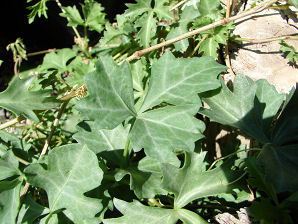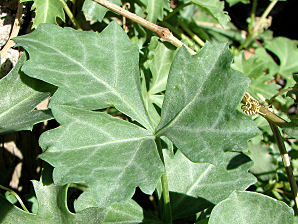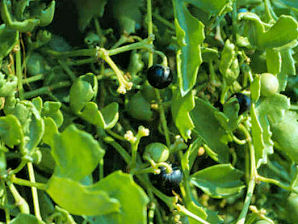Xeriscape Landscaping Plants For The Arizona Desert Environment.
Pictures, Photos, Information, Descriptions,
Images, & Reviews.
Vines.
Grape Ivy, Cissus trifoliata.
We Are Proud Of Our SafeSurf Rating!
Click On Any Of The Following Links By Amazon.Com
For Books, & Videos About Wildflowers Of Arizona & The Southwest USA. No Obligation!
| Grape Ivy, Cissus trifoliata; September 6, 2006. Glendale. |
|---|
 |  |
| Grape Ivy, Cissus trifoliata | Grape Ivy, Cissus trifoliata |
|---|---|
 | |
| Grape Ivy, Cissus trifoliata | Grape Ivy, Cissus trifoliata |
 /
/

Grape Ivy.
We wish to thank Wikipedia, the free encyclopedia for some of the information on this page. We share images and information with Wikipedia. A woody or semiwoody vine to 30 feet long with tuberous roots. Stems 4- or 6 ridged, with orange -red lenticels becoming warty. Used as an accent or background plant. This is a gray accent shrub that contrasts well against other shrubs with deep green foliage. It's fruits are black, 1 - 4 seeded, obovoid, 6 - 9 mm long. On the negative side, many people, especially in Texas, say that it is very invasive and that it has a terrible smell. They are trying to get rid of it!
Quick Notes:
Height: About 30 feet long.
Flowers: Small, greenish.
Flowering Time: March - April in Phoenix.
Leaves: Alternate, somewhat succulent, simple, trilobed, or trifoliate, to (3.1 inch long. Leaflets ovate to obovate, coarsely and irregularly toothed, producing a disagreeable odor when crushed.
Found: Native to the Yucatan Peninsula of Mexico, Guatemala, Brazil, & Argentina. The USDA claims it is native of the USA (AL, AR, AZ, FL, GA, KS, LA, MO, MS, NM, OK, TX), USA+ (PR, VI).
Hardiness:
Soil pH requirements:
Sun Exposure:
Elevation: 600 - 2,800 feet. Even though said to be hardy at higher elevations, we can find no - one growing it higher than in zone 9b.
Habitat: Chalky/alkaline, Dry, Sandy, Well-drained/light soils. Stream banks, rocky ravines, roadsides. An ideal xeriscape landscape plant in Arizona.
Miscellaneous: Photos Taken At Glendale, Arizona. September 6, 2006.
|



We Are Proud Of Our SafeSurf Rating!
Click On Any Of The Following Links By Amazon.Com
For Books, & Videos About Xerioscape Plants Of Arizona & The Southwest USA. No Obligation!
| © 1966 - Present, Audrey, Eve, & George DeLange |


